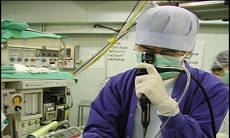Key Improvements within last 5 years
 Use of Ultra-sound to guide central venous access, especially in paediatric/ neonatal age groups. Also, increasing use of ultra-sound technology for arterial access in paediatrics
Use of Ultra-sound to guide central venous access, especially in paediatric/ neonatal age groups. Also, increasing use of ultra-sound technology for arterial access in paediatrics
- Shortens time to successful cannulation
- Minimizes complications; increased safety
Intra-operative Transoesophageal service: extending service to cover all adults and almost all paediatric and neonatal open heart surgery. The latter has been made possible with acquisition of the micro TEE probe which can be used in babies even less than 2.5-3 kg.
Anaesthesia for a large number of new procedures; these procedures need modification of routine cardiac anaesthetic technique:
- Minimally Invasive Cardiac Surgery, e.g., through mini-thoracotomy wounds enabling video-assisted thoracoscopic valve repair/ replacements surgery, repair of ASD, etc.
- Robotic cardiac surgery
- Hybrid procedures: Transcatheter Aortic Valve Implantation (TAVI) through transfemoral or transapical approach
- Structural Heart Disease Interventions by Cardiologists in Catheterization Labs:., - Left Atrial Appendage Occlusion - Mitra Clip
- Neochord
Teaching & Training ECMO: for nursing personnel-Crises Simulation and Lectures. Preceptorship Course on Transoesophageal Echocardiography (TEE): a 5-day hands-on course (1:1 supervision) on basic TEE, mainly aimed at specialists in Anaesthesia and Intensive therapy, 5-6 courses a years.
Preparation of designated space for a fully equipped MH Box in areas providing GA service.
Planning and preparation for the future Hong Kong Children’s Hospital
- 6 Senior staff sent for overseas training experience in Paediatric Cardiac Anaesthesia (Royal Children’s Hospital, Melbourne, Hospital for Sick Children, Toronto and Great Ormond Street Hospital, London).
- Surgical Safety Checklists: yearly audits and revision of checklists
- Extending checklists to Procedural Interventional Suites: Paed/ Adult Cardiac Cath Laboratories and Bedside procedures: Central Vascular Access with Guidewires
- Documentation: Anaesthesia Information System in OT & Cath Lab; Revision of Anaesthesia Record Chart, APS forms, Patient Information leaflets; Recording of specific risks while obtaining patient consent for anaesthesia
- Safety during Patient transport: Monitoring of CO2 (respiratory monitoring) in addition to haemodynamic monitoring during transport of intubated/ ventilated patients.
- Increased to 8 Specialists to address increase in number and complexity of workload.
- Increase in number of Consultant positions from 2 to 3.
- Increase in secretarial/clerical staffing to address increased administrative/ office-based workload.
- Strict compliance with HR regulations regarding working hours, rest-days, statutory holiday compensation, etc.
Equipment
- Airway Procuring new airway equipment including video laryngoscope, C MAC and disposable intubating LMA, Air Q for safer management of patients with difficult airway.
- Anaesthetic Machine New anaesthetic machines (Aespire, Primus) which provide more stable and reliable ventilating volumes to patients, especially small preterm neonate with body weight less than 2 kg.
- Introduction of new neonatal filter and end tidal CO2 sampling port which can fit in the ET tubes range from 2.5 to 3.5. This can greatly reduce the dead space in small neonate and infant.
- Storz camera which can fit into the eyepiece of bronchoscopes and project the image on TV: useful for teaching bronchial anatomy, facilitate bronchoscopic procedures and awake fibreoptic intubation.
Drugs Introduction of new drugs: Intravenous Paracetamol: as part of multi-modal analgesia for better pain-relief following thoracic and cardiac surgery. Neostigmine and Glycopyrrolate for reversal of muscle relaxant in patients who need protection from tachycardia.